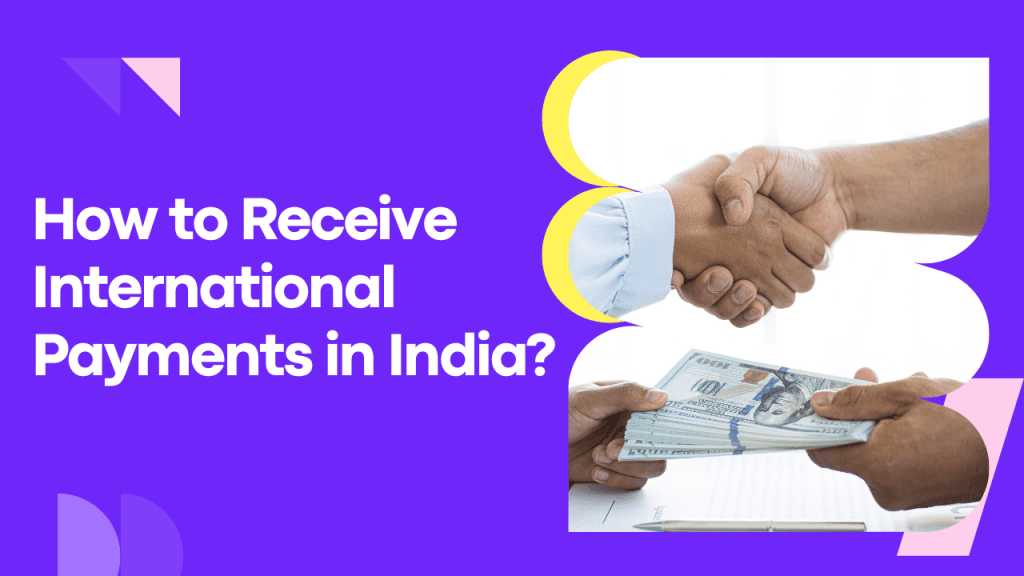So you have just got your first international client as a freelancer or as a business, and you don’t know how to receive payments from them, OR maybe you are just finding it hard to choose from so many options out there. Don’t worry. We are here to help you with exactly that.
Before choosing the best platform to receive international payments, you need to consider several factors like the fees, hidden fees, the time it takes for money to arrive in your bank account, transaction limits, ease of use, features, etc.
In India, there are basically two major mediums through which you can receive international payments and we will go through the details so that you can make an informed choice.
These two main mediums are:
- Banks
- Digital Money transfer services
1. Banks
Banks in India and around the world use the SWIFT system, which is an International payment network, to exchange currency and send money to each other. Nowadays though, banks are generally not the best way to receive overseas money transfers due to the cost involved. Also, the process can be complex and may require a lot of unnecessary documentation. Instead, many businesses are turning to payroll software, which can streamline international payments, reduce costs, and simplify the documentation process.
The fees charged by banks vary for different banks. In general, there are two main types of charges involved: 1) Transfer fees 2) Exchange rate margins
Other charges like fixed fees, commission fees, or other hidden fees may also be applicable and vary for each bank.
Some banks like HDFC don’t charge transfer fees, but they earn from the exchange rate margins. Understanding these exchange rate margins is very crucial to minimize your transaction costs. In layman’s terms, these margins are the difference between the exchange rate you see on Google vs the rate set up by the bank. This difference in the rates is what these banks profit from apart from the other fees mentioned above.
Cost: Average
Payer Convenience: Least
Payee Convenience: Least
Process Complexity: High
2. Digital Money transfer services
New-age startups have disrupted the traditional money transfer service market with innovative technologies, ease of use, lower fees, and other user-friendly features. These innovations, along with effective marketing strategies for startups, have positioned them as superior alternatives to banks for sending or receiving money across the globe.
There are many of these digital money transfer service providers out there. And we will review some popular ones so that you can make an informed decision.
1) Refrens
If you are a freelancer, agency, or small business; Refrens would be the ideal choice for you. Here is why:
- Best Forex rates across all other payment gateways.
- Lowest Fee In The Market. No hidden charges or amendment fees.
- Multiple Payment methods- Accept ACH, wire transfers, and all major credit/debit cards including Visa, Mastercard, and many others.
- Accept 100+ currencies including USD, EUR, GBP, SGD, and others.
- Shortest settlement Time of T+2 business days.
- Doesn’t require any integration – Start collecting payments with shareable invoices. Your clients can initialize payments in a single click.
- Highly secured with SSL, 24×7 live support, and a dedicated account manager.
- Unlimited Invoices for free- Create, share, track, and manage unlimited non-GST and GST invoices for free.
Cost: Lowest
Payer Convenience: High
Payee Convenience: High
Process Complexity: Less
2) PayPal
PayPal is one of the oldest and leading international payments gateway, but it has several downsides compared to other platforms:
- High fees for receiving money – PayPal charges high fees for receiving money transaction fees on international transfers It charges a 5% fee to senders who have to also incur the cost of exchange rate margin ranging from 2.5% to 4.5% when they send money to India with a non-local currency
- High currency conversion charge – Fees levied on non-PayPal payments could be a very expensive affair, about 3 to 4%.
- Paypal might freeze or limit account activity without any prior notice. Also, their inadequate customer support leaves a lot to be desired.
- It usually requires you to also open a Paypal account and then you get charged when you pull it into your regular bank account.
Cost: High, Good For Small Value
Payer Convenience: High
Payee Convenience: High
Process Complexity: Less
3) Payoneer
Payoneer allows users to pay in local accounts in USD, EUR, GBP, JPY, AUD, CAD & MXN. That makes it easier for your customers. And you can move the money into your INR account once it’s finished. But that does come with a 2% fee above the mid-market exchange rate to move to your local bank, plus fees to your customer.
It is still better than PayPal in terms of exchange rates and other charges. While for ease of use, and features provided PayPal outplays Payoneer. Refrens outplays both in terms of exchange rates, features, and ease of use for freelancers, agencies, and small businesses.
Cost: Average
Payer Convenience: High
Payee Convenience: Average
Process Complexity: Less
You can also receive payments via crypto but it is not allowed everywhere and the legality can be shaky, not to mention the risk and volatility as well.
Frequently asked questions:
1) Can I accept international payments in my bank account?
Yes, you can accept international payments directly to your bank account. With Refrens, you can collect International payments in 100+ currencies via ACH, wire transfer, and credit/debit cards. These payments will be deposited to your bank account in INR.
2) Do I get charged for receiving international payments?
Yes. No matter what platform you use to receive international payments, you will get charged one or another type of fee. However, choosing the platform with minimum rates is in your hands.
Traditional banks will charge you hefty amounts for receiving international payments.
PayPal also charges high fees for receiving international payments and also for pulling into your bank account. Also, you will have to face some forex loss due to differences in exchange rates offered by these platforms.
Refrens provides you best forex rates across all payment gateways, with the lowest fees in the market. Also unlike other platforms, there are no hidden charges or amendment fees. With Refrens, getting paid by your international clients is hassle-free and straightforward.
3) Is the payment received from international clients taxable?
Payments received as a freelancer for your work will be included in your total income for the financial year and taxed accordingly.
If you are a business, you are not taxed on the payment received but on your profits.
If you are an individual, and receiving payments in your personal account from your client, any amount above 50,000 Rs. is taxable.
4) What are the requirements for international payment on Refrens?
Different documentation requirements are depending on whether you are a freelancer or a proprietor.
5) What are the best alternatives to PayPal?
Although PayPal is one of the oldest platforms for receiving international payments, a lot of better alternatives provide better payment gateways for receiving payments via wire transfers, ACH, credit/debit cards, etc. These alternatives are often more affordable and user-friendly than PayPal, as it charge you high fees and high currency conversion charges compared to other alternatives.
Refrens is the best alternative to PayPal for receiving international payments as it provides you best forex rates across all payment gateways with the lowest fees in the market. Also unlike other platforms, there are no hidden charges or amendment fees.
Start accepting international payments on Refrens>
6) What things should you consider before choosing a platform to receive international payments?
Choosing the right platform for collecting international payments is crucial for any business. Make sure you get answers to the following questions before committing to any platform or service.
- What are the fees? Are there any hidden fees?
- How long does it take for money to arrive?
- Is there any minimum or maximum limit on the money you can receive?
- Does it have the features required for your needs?
- Is the platform easy to use?
If you are considering using Refrens, let us answer these questions for you.
A) What are the charges? Are there any hidden fees?
Refrens provides you best forex rates across all payment gateways with the lowest fees in the market. Also unlike other platforms, there are no hidden charges or amendment fees.
B) How long does it take for money to arrive?
Refrens have the shortest settlement time of T+2 days.
C) Is there any minimum or maximum limit on the money you can receive?
Refrens doesn’t have any limits on its own, but it is dependent on the limits of the sender’s bank or credit/debit card provider.
D) Does it have the features required for your needs?
If you are a freelancer, agency, or small business; Refrens has everything you need. Apart from collecting international payments, it also allows you to create unlimited invoices, send invoice reminders for overdue payments, and manage your business through robust sales CRM, top accounting software, intuitive expense management software, and more.
E) Is the platform easy to use?
Over 200K freelancers, businesses, and agencies are already using Refrens for their Payments, Invoicing, Accounting, Lead Management, Networking, and other business requirements. This is the testimony of our user’s love & trust for the platform for its user-friendliness.
7) Does Refrens provide e-FIRC?
Yes, you can easily get e-FIRC for international payments received on Refrens.
For further queries regarding international payments, drop a mail at pg@refrens.com.



















